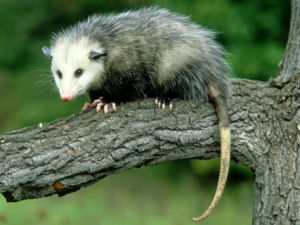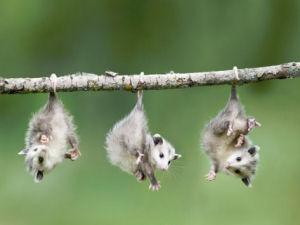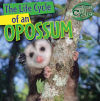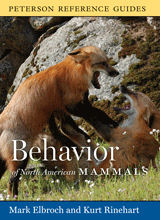
HOME
INTRO
SYMBOLS
ALMANAC
ECONOMY
GEOGRAPHY
STATE MAPS
PEOPLE
FORUM
NEWS
COOL SCHOOLS
STATE QUIZ
STATE LINKS
BOOK STORE
MARKETPLACE
NETSTATE.STORE
NETSTATE.MALL
GUESTBOOK
CONTACT US


Tweet
Double click on word for definition.
North Carolina State Marsupial

North Carolina State Marsupial: Virginia Opossum
Photographs, prints, posters for purchase
The Virginia opposom became the official state marsupial of the State or North Carolina when Governor Pat McCrory signed mega-symbol House Bill No. 830 on June 26, 2013.
The Virginia opossum is the only marsupial found north of Mexico. North Carolina is the only state to have adopted an official marsupial, unless you count Georgia which adopted an official 'Possum in 1992.
The five other symbols made official by mega-symbol House Bill No. 830 included:
- Official fossil of the State of North Carolina
- Official frog of the State of North Carolina
- Official salamander of the State of North Carolina
- Official folk art of the State of North Carolina
- Official art medium of the State of North Carolina
GENERAL ASSEMBLY OF NORTH CAROLINA
SESSION 2013SESSION LAW 2013-189
HOUSE BILL 830AN ACT to adopt an official state fossil, frog, Salamander, marsupial, folk art, and art medium.
Whereas, some of North Carolina's official State symbols have been suggested by the State's school children after they have had history, science, social studies, or geography lessons related to North Carolina; and
Whereas, this year some of the suggestions range from the adoption of an official fossil to an official frog; and
Whereas, the State of North Carolina has a number of unique official symbols but does not have an official fossil, frog, salamander, marsupial, folk art, or art medium; and
Whereas, the megalodon shark is an extinct shark species that lived over 1.5 million years ago; and
Whereas, the megalodon shark may have reached over 40 feet in length and weighed up to 100 tons; and
Whereas, the megalodon shark had serrated, heart-shaped teeth that may have grown to over seven inches in length; and
Whereas, fossilized teeth of the megalodon shark have been found in North Carolina and throughout the world; and
Whereas, North Carolina and the Southeast region of the United States lead the world in amphibian diversity; and
Whereas, the pine barrens tree frog can be found in the Sandhills and Coastal Plain regions of North Carolina; and
Whereas, the pine barrens tree frog has been considered one of the most striking and beautiful frogs in the Southeast region of the United States; and
Whereas, the pine barrens tree frog by name reflects one of North Carolina's signature trees and ecosystems that have been a vital part of the State's economic, cultural, and natural history since colonial times; and
Whereas, North Carolina also leads the nation and world in salamander diversity, most notably in our Appalachian Mountains; and
Whereas, the marbled salamander is found throughout the State and is unique in that it is a charismatic, striking, chunky-bodied, fossorial amphibian, of which no two are exactly alike in color pattern; and
Whereas, according the North Carolina Wildlife Commission's 2005 North Carolina Wildlife Action Plan, the pine barrens tree frog and the marbled salamander have been identified as priority species for population monitoring and conservation in North Carolina; and
Whereas, the Virginia opossum is native to North Carolina and is the only marsupial found in North America; the female carries its underdeveloped young in a pouch until they are capable of living independently, similar to a kangaroo; and
Whereas, the Virginia opossum is one of the oldest and most primitive species of mammal found in North America; and
Whereas, the Virginia opossum is about the size of a large house cat with a triangular head; a long pointed nose; dark eyes; a long, scaly, prehensile tail; and short, black, leathery ears; and
Whereas, the Virginia opossum is nocturnal and lives in a wide variety of habitats, including deciduous forests, open woods, and farmland but prefers wet areas such as marshes, swamps, and streams; and
Whereas, at age 65, Vollis Simpson, a self-taught folk artist, began making giant windmills known as "whirligigs" at his home in Wilson, North Carolina; and
Whereas, Mr. Simpson's whirligigs have been exhibited at the North Carolina Museum of Art in Raleigh, the High Museum of Art in Atlanta, Georgia, and the Visionary Art Museum in Baltimore, Maryland, and at other locations, including New York, California, Canada, and England; and
Whereas, Mr. Simpson and details of his artwork have been featured in many national magazines and in several books; and
Whereas, the City of Wilson is developing the Vollis Simpson Whirligig Park to display a large collection of these whirligigs in historic downtown, which will be a one‑of‑a‑kind destination for visitors; and
Whereas, North Carolina's clay-rich soil has contributed to the State's pottery heritage; and
Whereas, the use of clay has grown from the State's early Native Americans making mostly utilitarian wares and European settlers continuing the traditions of their ancestors to today's potters designing pottery with utilitarian and aesthetic elements; and
Whereas, the pottery tradition continues to thrive in North Carolina, especially in the Seagrove area, which includes parts of Chatham, Lee, Moore, Montgomery, and Randolph Counties; and
Whereas, clay continues to be an important art medium contributing to the State's cultural, social, and economic prosperity; Now, therefore,
The General Assembly of North Carolina enacts:
SECTION 1. Chapter 145 of the General Statutes is amended by adding the following new sections to read:
§ 145-41. State fossil.
The fossilized teeth of the megalodon shark is adopted as the official fossil of the State of North Carolina.
"§ 145-42. State frog.
The pine barrens tree frog (Hyla andersonii) is adopted as the official frog of the State of North Carolina.
"§ 145-43. State salamander.
The marbled salamander (Ambystoma opacum) is adopted as the official salamander of the State of North Carolina.
"§ 145-44. State marsupial.
The Virginia opossum (Didelphis virginiana) is adopted as the official marsupial of the State of North Carolina.
"§ 145-45. State folk art.
The whirligigs created by Vollis Simpson are adopted as the official folk art of the State of North Carolina.
"§ 145-46. State art medium.
Clay is adopted as the official art medium of the State of North Carolina."
SECTION 2. This act is effective when it becomes law.
In the General Assembly read three times and ratified this the 20th day of June, 2013.
s/ Philip E. Berger
President Pro Tempore of the Senate
s/ Thom Tillis
Speaker of the House of Representatives
s/ Pat McCrory
GovernorApproved 4:24 p.m. this 26th day of June, 2013
Sources...
Avila, Marilyn, Susan Martin, Pat McElraft, and Roger West. "House Bill 830 / S.L. 2013-189." North Carolina General Assembly. The State of North Carolina, 06 Jun 2013. Web. 20 Jul 2013.
"Didelphis virginiana." North American Mammals. Smithsonian National Museum of Natural History. Web. 22 Jul 2013.
Additional Information

North Carolina State Marsupial: Virginia Opossum
Photographs, prints, posters for purchase
Didelphis virginiana (Virginia Opossum): Smithsonian Museum of Natural History - North American Mammals.
Didelphis virginiana (Virginia opossum): The University of Michigan Museum of Zoology: Animal Diversity Web.
Didelphis virginiana {Kerr, 1792), Virginia Opossum: A network connecting science with conservation - NatureServe Explorer: An Online Encyclopedia of Life.
Didelphis virginiana (Kerr, 1792): Integrated Taxonomic Information System (ITIS) Here you will find authoritative taxonomic information on plants, animals, fungi, and microbes of North America and the world.
State mammals: Complete list of official state mammals from NETSTATE.COM
More symbols & emblems: Complete list of official North Carolina state symbols from NETSTATE.COM.

Opossum at
Sycamore Road
Sally M. Walker
Opossum at Sycamore Road,
by Sally M. Walker. 32 pages. Publisher: Soundprint (September 1, 1997) Reading level: Ages 4+.
It's nighttime. Opossum and her four babies waddle across a backyard, rummaging through trash cans for food. Suddenly a dog pops out of nowhere! Will Opossum be able to protect her young?

There's an Opossum
in My Backyard
Gary Bogue
There's an Opossum in My Backyard,
by Gary Bogue. 40 pages. Publisher: Heyday; First Edition edition (August 1, 2007) Reading level: 4-9.
A baby opossum falls off her mother’s back and finds herself in a strange new world—a suburban backyard. As the Green family and the opossum become acquainted with each other, the adventurous creature learns to sneak food from the dog bowl, avoid capture by an owl, and make friends with other wildlife along the way.

Opossums
JoAnn Early Macken
Opossums,
by JoAnn Early Macken. 24 pages. Publisher: Gareth Stevens Publishing (January 2005) Reading level: Grade 1.
Night falls as an opossum hurries through the forest. She carries her babies on her back as she looks for food. When an enemy approaches, she lies perfectly still until the danger has passed. In Opossums, learn how this tiny creature survives in the forest.

The Life Cycle
of an Opossum
Barbara M. Linde
The Life Cycle of an Opossum,
by Barbara M. Linde. 24 pages. Publisher: Gareth Stevens Publishing (January 2011) Reading level: Grades 2-3.
Why does a baby opossum live in its mother’s pouch? When can an opossum live on its own? Why are humans a danger to opossums? From inside the mother’s pouch to life outside the den, this is an engaging exploration of America’s only wild marsupial. Fun facts and vivid photographs teach readers about every stage of an opossum’s life.

Behavior of North
American Mammals
Mark Elbroch
Kurt Rinehart
Peterson Reference Guide to the Behavior of North American Mammals,
by Mark Elbroch, Kurt Rinehart. 374 pages. Publisher: Houghton Mifflin Harcourt; 1 edition (October 25, 2011)
A reference guide to the behavior of North American mammals, including Virginia opossums.
Oftentimes when we glimpse an animal in the wild, we have no idea what we’ve seen. We want to know, and field guides are an ideal aid for identification. But when we want to know more about the lives of these animals—their natural histories, their place in the larger ecological community, and where to look for them in the future—we can now turn to Behavior of North American Mammals.
For example, when an opossum plays dead it isn't pretending: opossums actually do enter a catatonic deathlike state. Armadillos sequester air in their guts, blow up to twice their normal volume, and paddle across the water. And beavers stockpile food for winter by caching it in beneath a raft of branches, which gets frozen in place and keeps them well supplied until spring.

